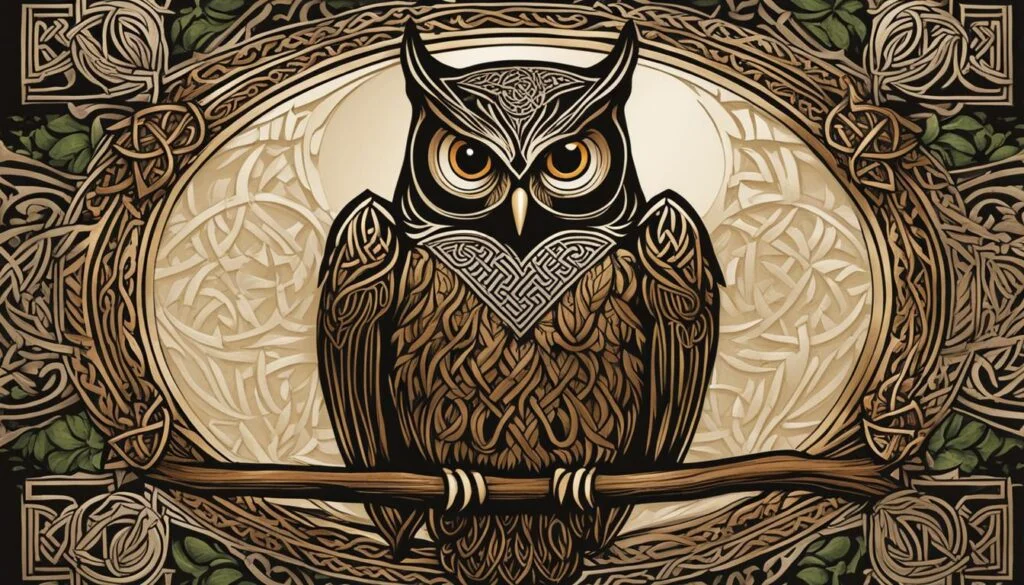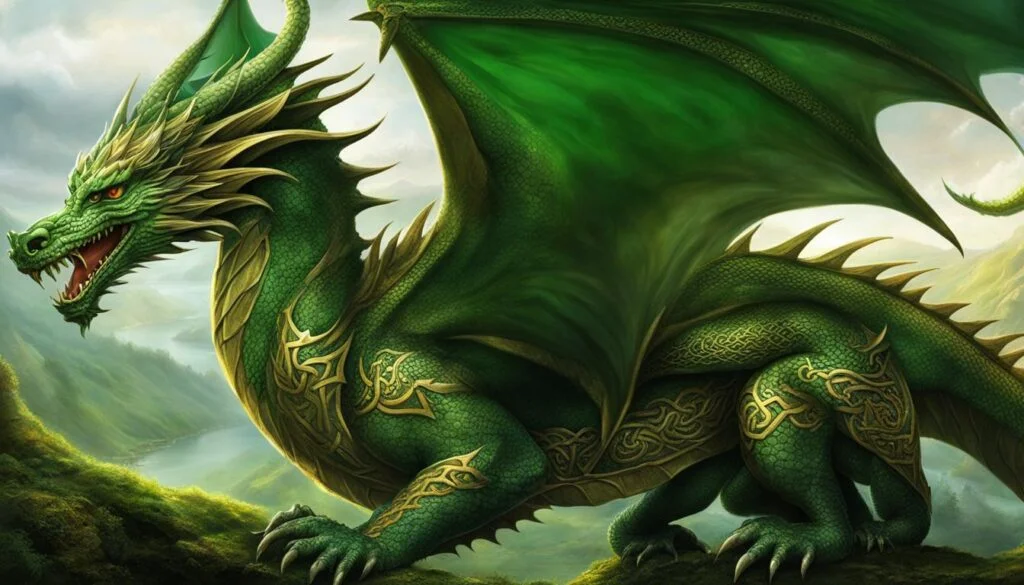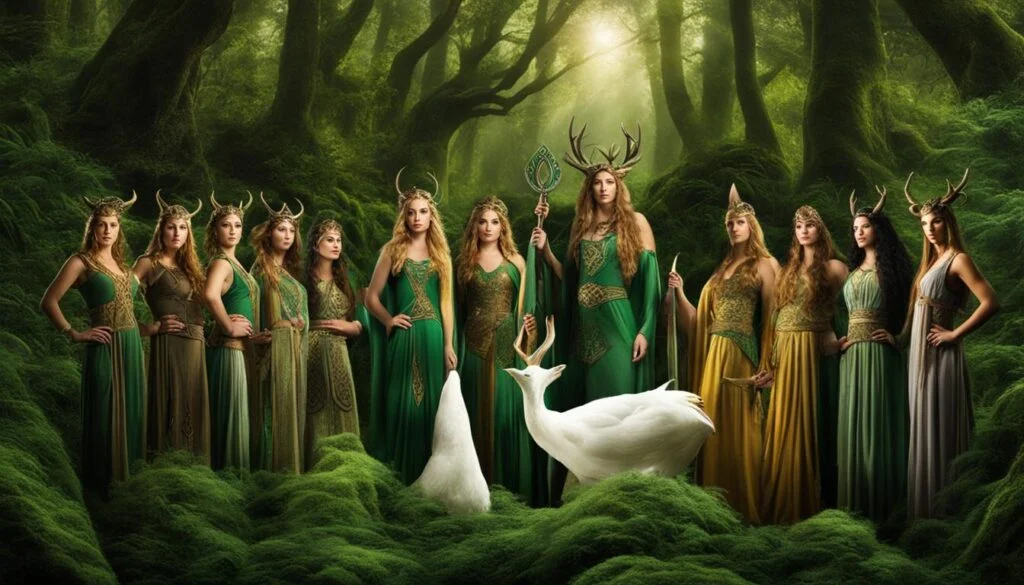In Celtic mythology, the owl holds profound symbolism and is associated with various aspects of the ancient Celtic culture and spirituality. Through its representation in Celtic folklore, it is believed to embody wisdom, spiritual insight, and connections to the Underworld. The owl is often associated with the Crone aspect of the Celtic Hag Goddess “Cailleach” and is considered a guide and protector in the dark. It is believed that the owl can unveil deception and provide wisdom to those who seek it. Furthermore, owls are seen as divine messengers or intermediaries between different realms in some societies, and they are revered as symbols of knowledge and insight.
Key Takeaways:
- The owl holds profound symbolism in Celtic mythology, representing wisdom and spiritual insight.
- It is associated with the Crone aspect of the Celtic Hag Goddess “Cailleach” and serves as a guide and protector in the dark.
- Owls are believed to unveil deception and provide wisdom to those who seek it.
- They are seen as divine messengers and symbols of knowledge and insight in Celtic culture.
- The owl’s symbolism reflects the ancient Celts’ beliefs about spirituality and the interconnectedness of different realms.
The Owl in Celtic Culture
Owls hold significance in Celtic culture and are regarded as creatures of wisdom and mystery. They are often seen as spiritual guides and messengers, playing prominent roles in Celtic folklore and tradition. Celtic beliefs about owls are deeply rooted in the spiritual significance they hold.
In Celtic culture, owls are associated with the Cailleach, a divine hag or goddess who symbolizes nature, winter, and the cycle of death and rebirth. The owl is believed to be a companion of the Cailleach, representing her power over the unseen forces in the world. This connection highlights the owl’s role as a symbol of wisdom and insight, guiding individuals through the cycles of life.
Additionally, owls are closely connected to the Owl Goddess, a deity associated with the moon, night, and feminine energy. The owl embodies the sacred feminine and intuition, reflecting the profound spiritual significance of this mystical creature in Celtic mythology.
Throughout Celtic culture and tradition, the owl is revered as a symbol of spiritual enlightenment and deep connection with the unseen world. Its presence in Celtic folklore and mythology underscores its importance as a guide, protector, and messenger between realms.
The Owl in Celtic Mythology
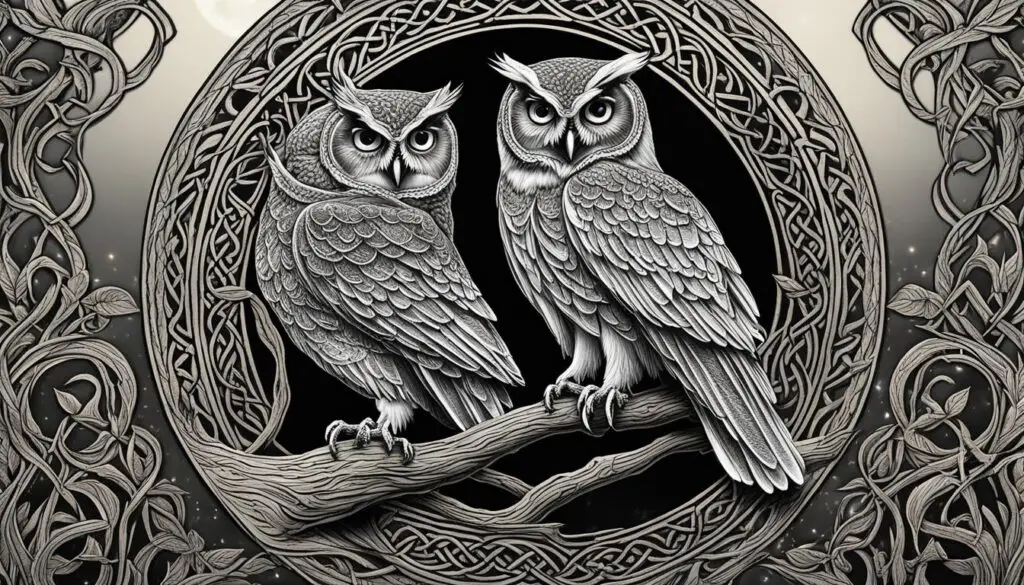
In Celtic mythology, the owl holds various roles and symbolizes different aspects of the ancient Celtic culture. It is often associated with the mystical Underworld and serves as a guide to navigate the realm of the dead. With its keen sight in darkness and silent hunting abilities, the owl represents knowledge and insight in ancient Celtic culture.
The owl’s symbolism extends beyond its hunting prowess. It is believed to have the power to unmask deceivers and protect against those who would take advantage. Owls are seen as guardians of sacred knowledge, keeping the secrets of the universe from misuse. In Celtic mythology, the owl’s presence highlights its significance in the spiritual and mythological beliefs of the Celts.
Throughout Celtic folklore, the owl is revered for its wisdom and connection to the spiritual realm. It is seen as a divine messenger, delivering important messages between different realms. Owls embody the allure of the night and the mysteries hidden within the darkness. They are symbols of both spiritual insight and the unknown, guiding individuals through life’s challenges and offering profound wisdom.
As guardians of sacred knowledge and messengers between worlds, owls hold a special place in Celtic mythology. Their symbolism represents the eternal quest for wisdom and the unseen spiritual forces that shape our lives. Owls are a reminder to seek knowledge, navigate the shadows of the unknown, and embrace the magical aspects of life.
Owls in Celtic Folklore
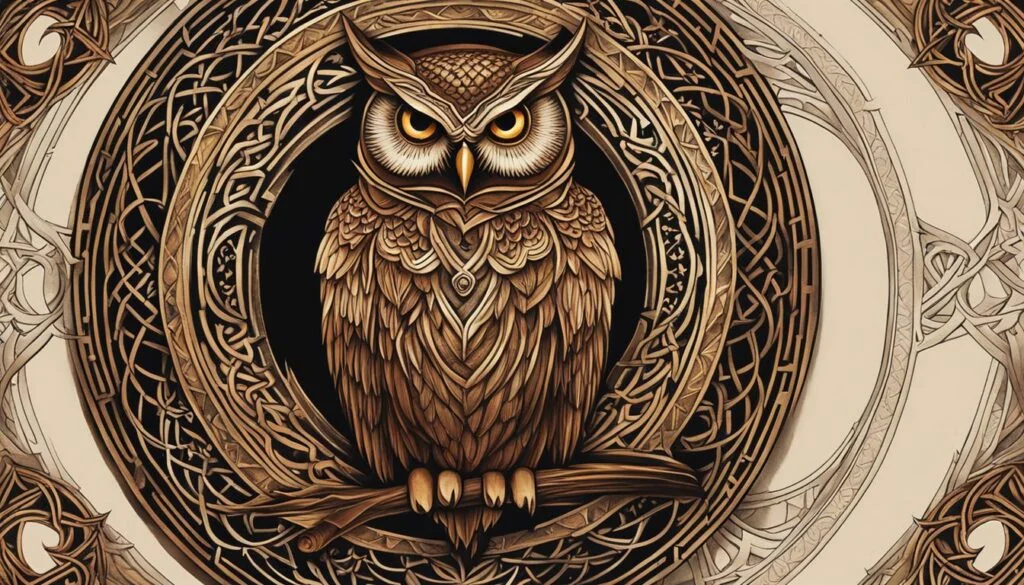
Owls hold a significant place in Celtic folklore, where they are often regarded as foretellers of events and symbols of transformation. The haunting cries of owls gave rise to the myth of the banshee, a female ghost associated with predicting death. It is believed that the banshee’s cries are an omen of impending death. Additionally, owls are sometimes considered the bird of Gwyn ab Nudd, the King of the Faerie in Celtic tradition. In Celtic folklore, owls are also associated with the cycle of life and death, representing the balance between light and darkness, creation and destruction.
According to Celtic beliefs, owls possess a spiritual significance that goes beyond ordinary birds in Celtic mythology. Their ability to navigate the darkness and their mysterious aura led to their association with the prophetic powers of the banshee. The banshee, often depicted as a woman crying out in the night, was believed to herald impending death. The chilling cries of the owl were seen as an omen, foretelling the passing of a loved one.
In addition to their connection to death and transformation, owls are regarded as sacred creatures associated with the realm of the faeries. In Celtic folklore, Gwyn ab Nudd, the King of the Faerie, is said to have an owl as his bird companion. This association with the Faerie realm further deepens the spiritual significance of owls in Celtic culture.
The owl’s symbolic role also extends to the cycle of life and death. Owls are viewed as embodying the balance between light and darkness, creation and destruction. They are seen as guardians of this delicate equilibrium and are believed to guide souls through the transition from one existence to the next.
In conclusion, owls play a significant role in Celtic folklore, representing not only death and transformation but also the mystical connection between the mortal world and the realm of the faeries. Their haunting cries and enigmatic presence make them powerful symbols of the spiritual and mythical beliefs of the ancient Celts.
Owl Symbolism in Celtic Art and Tattoos
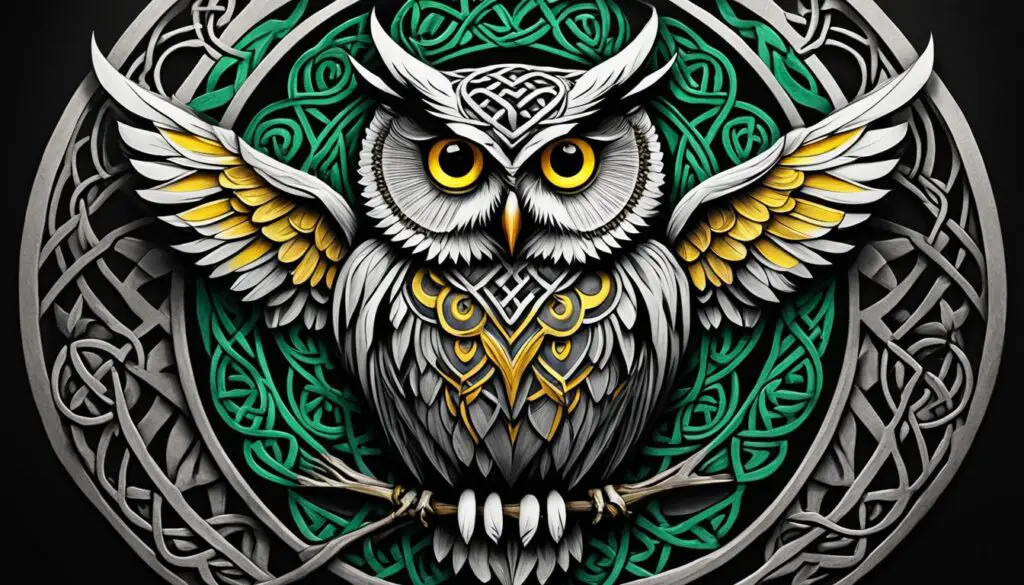
In Celtic art and tattoos, the owl holds a special place as a symbol of wisdom, mystery, and spirituality. Incorporating owl symbolism into Celtic designs is a way for individuals to honor and celebrate Celtic mythology and culture.
Celtic art is characterized by intricate patterns and designs, such as the famous Celtic knots, that represent the interconnectedness of all things and the cyclical nature of life, death, and rebirth. Within these artistic creations, owls are often included to convey their symbolic significance.
Symbolizing wisdom, the owl represents the deep understanding and insight gained through experience and observation. Owls are known for their ability to see clearly in the darkness, offering guidance and illuminating hidden truths. In Celtic culture, the owl embodies the pursuit of knowledge and the desire for spiritual growth.
The image above showcases a captivating example of Celtic art featuring an owl. The intricate details and flowing lines draw attention to the owl, emphasizing its symbolic importance in Celtic culture and mythology.
Celtic owl tattoos are highly popular among those who wish to embrace the wisdom and beauty of the natural world while honoring their Celtic heritage. These tattoos often carry personal significance and can be customized to reflect an individual’s story and spiritual journey.
By adorning oneself with a Celtic owl tattoo, one not only pays homage to Celtic mythology but also strives to embody the timeless qualities associated with owls. The permanence of the tattoo serves as a constant reminder to seek wisdom and spiritual insight, embracing the profound symbolism of the owl in Celtic culture and mythology.
The Decline of Owls in Celtic Countries
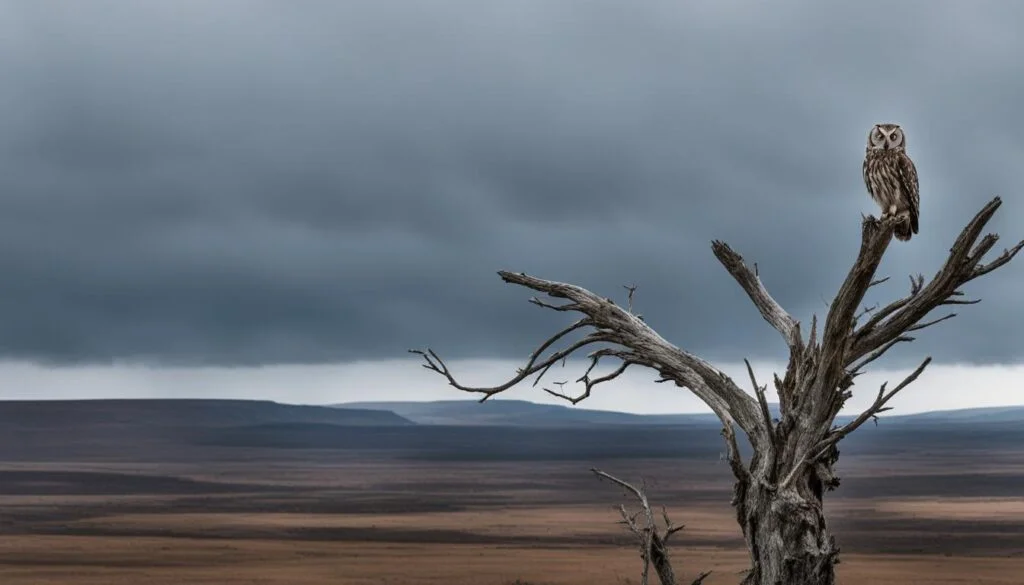
The owl population in Celtic countries, such as Ireland, has been experiencing a significant decline over the past few decades. This decline is particularly noticeable in the barn owl population, which has seen a decrease of over fifty percent in the last quarter-century.
This concerning decline in owl numbers has led to the barn owl being listed as a species of concern on the IUCN Red List of Ireland. The decrease in owl population can be attributed to various factors, including habitat loss, pesticide use, and changes in agricultural practices.
Conservation efforts are being made to address this decline and protect the owl population in Celtic countries. Organizations and authorities are working together to preserve owl habitats, implement sustainable farming practices, and raise awareness about the importance of owl conservation.
By understanding and addressing the factors contributing to the decline of owls in Celtic countries, we can strive to ensure the long-term survival of these magnificent creatures. Protecting owl populations not only benefits the natural ecosystem but also preserves the rich cultural heritage and symbolism associated with owls in Celtic mythology and folklore.
Modern Interpretations of Celtic Owl Symbolism
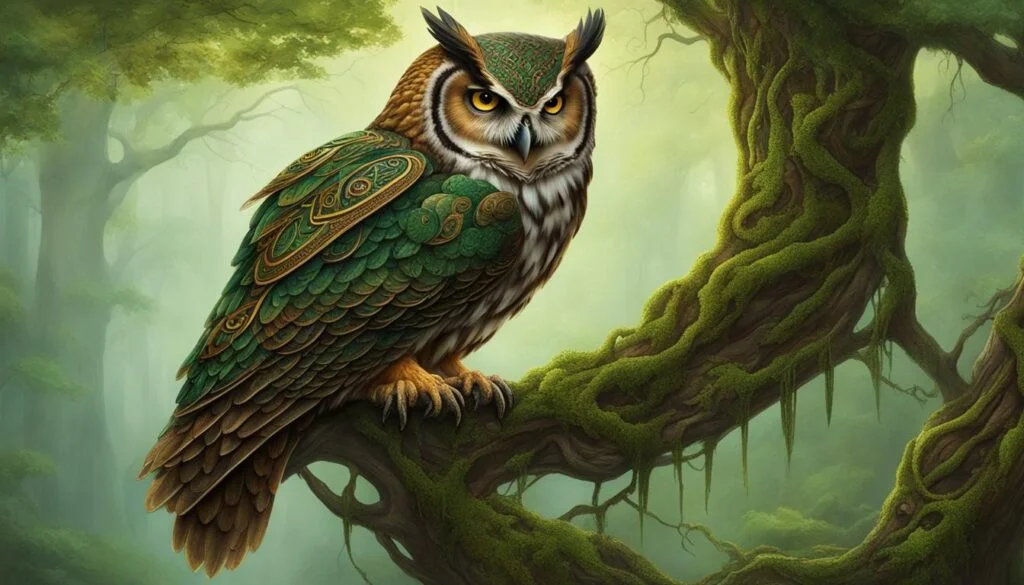
In modern times, Celtic owl symbolism has gained popularity among tattoo enthusiasts worldwide. Celtic owl tattoos provide a meaningful way to connect with the ancient Celtic culture and its rich mythology, while also representing wisdom, mystery, and a deep connection to the spiritual realm.
These tattoos offer a chance for individuals to express their own spiritual journey and desire for personal growth and transformation. Through the intricate designs and symbolism of Celtic owl tattoos, wearers can embody the wisdom and guidance of the owl as they navigate their own life’s path.
Each Celtic owl tattoo can be personalized to reflect the individual’s unique story and beliefs, ensuring a truly meaningful and personal representation. These tattoos serve as powerful talismans, guiding and protecting those who wear them on their journey towards self-discovery and enlightenment.
Whether it’s a small, discreet design or a larger, intricate piece, Celtic owl tattoos continue to captivate individuals who wish to honor their Celtic heritage and embrace the profound symbolism of the owl. The popularity of these tattoos showcases the enduring fascination with ancient Celtic culture and its timeless wisdom.
Conclusion
Owls play a significant role in Celtic culture and mythology, embodying wisdom, mystery, and spiritual guidance. They are deeply intertwined with the folklore, art, and beliefs of the ancient Celts. Associated with powerful deities like the Cailleach and the Owl Goddess, the owl is seen as a messenger between the physical and spiritual realms in Celtic mythology.
The profound symbolism of the owl in Celtic culture has led to its popularity in Celtic owl tattoos. These tattoos have become a meaningful way for individuals to honor their Celtic heritage and embrace the rich history and traditions of the Celts. By wearing a Celtic owl tattoo, people can connect with the wisdom, beauty, and spiritual essence that the owl represents in Celtic mythology.
Celtic owl symbolism resonates with those who seek wisdom, knowledge, and guidance in their lives. Owls, as spiritual beings, inspire us to explore the hidden realms of our existence and to embrace the mysteries of life. Whether in folklore, art, or tattoos, the owl continues to be a powerful symbol that reminds us of the deep spiritual connection between ourselves and the ancient Celtic traditions.
FAQ
What does the owl symbolize in Celtic mythology?
In Celtic mythology, the owl symbolizes wisdom, spiritual insight, and connections to the Underworld. It is associated with the Crone aspect of the Celtic Hag Goddess “Cailleach” and is considered a guide and protector in the dark.
How is the owl revered in Celtic culture?
Owls are regarded as creatures of wisdom and mystery in Celtic culture. They are seen as spiritual guides and messengers and are associated with the Owl Goddess, a deity associated with the moon, night, and feminine energy.
What is the significance of the owl in Celtic mythology?
In Celtic mythology, the owl is associated with the Underworld and is believed to possess knowledge and insight. It can unmask deceivers and protect against those who would take advantage. Owls are also seen as guardians of sacred knowledge.
How do owls feature in Celtic folklore?
Owls are often regarded as foretellers of events and symbols of transformation in Celtic folklore. They are associated with the myth of the banshee, a female ghost believed to predict death. Additionally, they are considered the bird of Gwyn ab Nudd, the King of the Faerie in Celtic tradition.
How do owls symbolize wisdom in Celtic art and tattoos?
In Celtic art and tattoos, owls represent wisdom, mystery, and a connection to the spiritual world. They are often incorporated into intricate patterns and designs, such as Celtic knots, to symbolize the interconnectedness of all things and the cyclical nature of life, death, and rebirth.
What is the status of owl populations in Celtic countries?
The owl population in Celtic countries, such as Ireland, has seen a significant decline over the past few decades, particularly the barn owl. Conservation efforts are being made to preserve and protect the owl population in these countries.
How is Celtic owl symbolism interpreted in modern times?
Celtic owl symbolism is embraced by tattoo enthusiasts worldwide. Celtic owl tattoos serve as personal talismans, connecting the wearer to the wisdom, beauty, and spiritual essence of the ancient Celts.
What is the significance of owl symbolism in Celtic mythology?
Owl symbolism holds profound meaning in Celtic mythology, representing wisdom, mystery, and spiritual guidance. Owls are associated with powerful deities and are seen as messengers between the physical and spiritual worlds.


